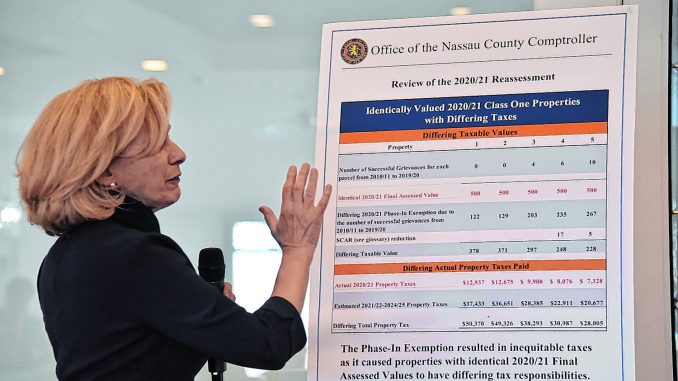
Bad data, Nassau County Comptroller Elaine Phillips suggested, may have contributed to the county’s reassessment problems.
Phillips related what her audit of the county’s Department of Assessment (DOA) had found as she spoke at the Manhasset Chamber of Commerce installation luncheon on Jan. 18.
Her office had been asked by Nassau County Executive Bruce Blakeman to take a look at the DOA’s reassessment undertaken at the direction of then-Executive Laura Curran, who lost to Blakeman in the 2021 election. Curran had argued that values for the approximately 386,000 residences and 37,000 businesses in the county were unrealistic due to the actions of her predecessor Edward Mangano, who froze the assessment rolls. Her administration introduced tentative assessment rolls on Jan. 2, 2019 and the reassessment was controversial, with many residents finding their home values for taxation purposes rising dramatically while others saw a reduction. Critics charged that the new rolls were filled with errors and rewarded those who filed tax certioraris (grieving the assessed value).
Phillips stated that Mangano had hired a pair of expert valuation firms, Standard Valuation Services (SVS) and Michael Haberman Associates, Inc. (MHA) to review the DOA’s “property information, assessment processes and the ability of its software system, ADAPT, to produce valuations.”
The experts put out their respective reports in December 2017 and January 2018, during the transition to Curran and her taking office. Both, according to the recent audit, “indicated significant weaknesses in the property information and characteristic data maintained by the [DOA].”
The new administration hired the same two companies and asked them to come up with a reassessment by September 2018, despite their warnings about the imperfect data and lack of time to correct it. To ease the shock of the new valuation, Curran got the state legislature to allow her administration to phase-in the higher tax rates over a period of five years for residential properties.
“If analysis and quality control had been done before that reassessment got released, I am confident that the errors and the impact that it had on us as property owners would not have been as severe,” Phillips said. “The fact is, the data and our assessment system had errors.”
Her auditors also found that DOA employees were entering data from the county clerk’s office, such as deeds and title transfers which contained valuable property information, by hand.
“The [data input] process was backed up by months, if not years,” she said.
She emphasized that the “goal [of the audit] is not to point fingers. The goal is to make sure that any administration—it may be the current or a future administrations—doesn’t make any mistakes that were made in the past.”
She pointed to a poster in which five similar properties with exact assessed values were listed and noted that those who had grieved multiple times had a much lower tax liability, in some cases by tens of thousands of dollars.
“They rewarded those homeowners that had grieved and they penalized homeowners that never grieved,” Phillips summed up.
“Taxpayers in Nassau County have the right to expect fair and equitable property valuations, conducted with transparency,” Phillips said in a statement. “Restoring trust in government is among my highest priorities, and integrity and fairness in assessed values are among our residents’ top concerns. This review of the 2020/21 Reassessment sheds light on a deeply flawed process and makes recommendations for the improvement of the county’s property assessment process going forward.”
Read a longer story at www.longislandweekly.com.

